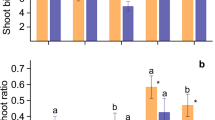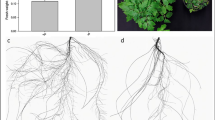Abstract.
Release of large amounts of citric acid from specialized root clusters (proteoid roots) of phosphorus (P)-deficient white lupin (Lupinus albus L.) is an efficient strategy for chemical mobilization of sparingly available P sources in the rhizosphere. The present study demonstrates that increased accumulation and exudation of citric acid and a concomitant release of protons were predominantly restricted to mature root clusters in the later stages of P deficiency. Inhibition of citrate exudation by exogenous application of anion-channel blockers such as ethacrynic- and anthracene-9-carboxylic acids may indicate involvement of an anion channel. Phosphorus-deficiency-induced accumulation and subsequent exudation of citric acid seem to be a consequence of both increased biosynthesis and reduced metabolization of citric acid in the proteoid root tissue, indicated by increased in-vitro activity and enzyme protein levels of phosphoenolpyruvate carboxylase (EC 4.1.1.31), and reduced activity of aconitase (EC 4.2.1.3) and root respiration. Similar to citric acid, acid phosphatase, which is secreted by roots and involved in the mobilization of the organic soil P fraction, was released predominantly from proteoid roots of P-deficient plants. Also 33Pi uptake per unit root fresh-weight was increased by approximately 50% in juvenile and mature proteoid root clusters compared to apical segments of non-proteoid roots. Kinetic studies revealed a K m of 30.7 μM for Pi uptake of non-proteoid root apices in P-sufficient plants, versus K m values of 8.5–8.6 μM for non-proteoid and juvenile proteoid roots under P-deficient conditions, suggesting the induction of a high-affinity Pi-uptake system. Obviously, P-deficiency-induced adaptations of white lupin, involved in P acquisition and mobilization of sparingly available P sources, are predominantly confined to proteoid roots, and moreover to distinct stages during proteoid root development.
Similar content being viewed by others
Author information
Authors and Affiliations
Additional information
Received: 10 September 1998 / Accepted: 22 December 1998
Rights and permissions
About this article
Cite this article
Neumann, G., Massonneau, A., Martinoia, E. et al. Physiological adaptations to phosphorus deficiency during proteoid root development in white lupin. Planta 208, 373–382 (1999). https://doi.org/10.1007/s004250050572
Issue Date:
DOI: https://doi.org/10.1007/s004250050572




